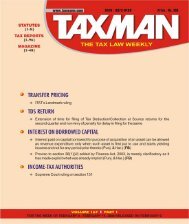news round up - Taxmann
news round up - Taxmann
news round up - Taxmann
- TAGS
- news
- round
- taxmann
- taxmann.com
Create successful ePaper yourself
Turn your PDF publications into a flip-book with our unique Google optimized e-Paper software.
2010] GST - THE SCENARIO IN SOME OTHER COUNTRIES 117<br />
provincial Quebee Sales Tax (QST). It is the only province to administer the<br />
federal tax.<br />
Certain services have the tax added in such a way that the total cost is<br />
<strong>round</strong>ed to the nearest multiple of cents.<br />
Almost everyone has to pay GST/HST on purchase of taxable s<strong>up</strong>plies of<br />
goods and services (other than zero-rates s<strong>up</strong>plies). Some sales or s<strong>up</strong>plies<br />
are exempt from GST/HST. Although the consumer pays the tax, businesses<br />
are generally responsible for collecting and remitting it to the<br />
Government. Businesses that are required to have a GST/HST registration<br />
number are called registrants. Taxable s<strong>up</strong>plies refer to s<strong>up</strong>plies of<br />
goods and services that are provided in the course of a commercial activity<br />
and are subject to GST/HST, or are 0 per cent (zero-rated).<br />
Zero-rated s<strong>up</strong>plies refer to a limited number of goods and services that<br />
are taxable at the rate of 0 per cent. This means that there is no GST/HST<br />
charged on the s<strong>up</strong>ply of these goods and services, but GST/HST registrants<br />
can claim an ITC for the GST/HST they pay or owe on purchases<br />
and expenses made to provide them.<br />
Exempt s<strong>up</strong>plies are goods and services that are not subject to GST/HST.<br />
Registrants cannot claim input tax credits to recover the GST/HST they<br />
pay or owe on expenses related to such s<strong>up</strong>plies.<br />
Effective from January 1, 2008, the GST rate is reduced from 6 per cent<br />
to 5 per cent, and the HST rate from 14 per cent to 13 per cent.<br />
In Canada, GST is a multilevel VAT implemented because the Manufacturers<br />
Sales Tax (MST) was hurting this sector’s ability to export. GST<br />
helped the Canadian economy, became more efficient and competitive<br />
with lower priced goods for the international market. It accounts for<br />
approximately 15 per cent to 17 per cent of total federal revenues.<br />
2.4 SINGAPORE GST - GST was first introduced in Singapore on April 1, 1994<br />
at 3 per cent. The GST rate was increased to 4 per cent in 2003 and 5 per<br />
cent in 2004. The GST rate was raised to 7 per cent in 2007. It is levied on :—<br />
� Goods and services s<strong>up</strong>plied in Singapore by any taxable person in<br />
the course or furtherance of a business; and<br />
� Goods imported into Singapore by any person.<br />
In general, a s<strong>up</strong>ply is either taxable or exempt. A taxable s<strong>up</strong>ply is that one<br />
which is taxable at standard rate or zero rate. Only a standard rated s<strong>up</strong>ply<br />
is liable to 7 per cent.<br />
Zero-rating a s<strong>up</strong>ply means applying GST at 0 per cent for the transaction.<br />
A GST registered trader need not charge GST on his zero-rated s<strong>up</strong>plies,<br />
but he is, nevertheless, allowed a credit of the tax he has paid on his inputs.<br />
In Singapore, only ‘export’ of goods and ‘international’ services are zerorated.<br />
If a s<strong>up</strong>ply is exempt from GST, no tax is chargeable on it. A GST<br />
registered trader does not charge his customer any GST on his exempt<br />
s<strong>up</strong>plies. At the same time, he is not entitled to claim input tax credits for<br />
GOODS & SERVICES TAX CASES ❑ JANUARY 20 - FEBRUARY 4, 2010 ◆ 27











![“FORM NO. 3CEB [See rule 10E] Report from an ... - Taxmann](https://img.yumpu.com/45480232/1/190x245/form-no-3ceb-see-rule-10e-report-from-an-taxmann.jpg?quality=85)





